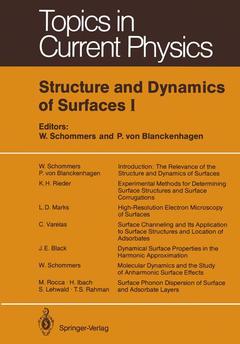Structure and Dynamics of Surfaces I, Softcover reprint of the original 1st ed. 1986 Topics in Current Physics Series, Vol. 41
Langue : Anglais
Coordonnateurs : Schommers W., Blanckenhagen P.v.

During the last decade, surface research has clearly shifted its interest from the macroscopic to the microscopic scale; a wealth of novel experimental techniques and theoretical methods have been applied and developed successfully. The Topics volume at hand gives an account of this tendency. For the understanding of surface phenomena and their exploitation in tech nical applications, the theoretical and experimental analysis at the microscopic level is of particular interest. In heterogeneous catalysis, for example, a chemical reaction takes place at the interface of two phases, and the process occurring at the surface is composed of a sequence of individual microscopic steps. These individual steps include adsorption, desorption, surface diffusion, and reaction on the surface. These elementary steps are greatly influenced by the structure and the dynamics of the surface region. Especially the catalytic activity may strongly depend on the structure of the catalyst's surface. The necessity of per forming surface investigations on a microscopic scale is also reflected clearly in research work relating to metal-semiconductor interfaces which determine es sentially the properties of electronic device materials. The experimental probe on the atomic scale, coupled with parallel theoretical calculations, showed that the electronic properties of a metal-semiconductor interface strongly depend on the crystallographic structure of the semiconductor; in particular, it is im portant to know in this context the modification of the atomic arrangement in the surface region caused by the termination of the crystal by the surface.
1. Introduction: The Relevance of the Structure and Dynamics of Surfaces.- 1.1 Structure of Surfaces.- 1.1.1 Effect of Relaxation on Electronic Surface Properties.- 1.1.2 Heterogeneous Catalysis.- 1.2 Dynamics of Surfaces.- 1.2.1 Surface Thermodynamic Functions in the Harmonic Approximation.- 1.2.2 Electron-Phonon Coupling.- 1.3 Conclusion and Outlook.- References.- 2. Experimental Methods for Determining Surface Structures and Surface Corrugations..- 2.1 Basic Physical Principles.- 2.2 Notation and Conventions.- 2.3 Surface Diffraction from Regular Gratings.- 2.3.1 Kinematical Interference Conditions for Surface Scattering.- 2.3.2 Experimental Methods Employing Diffraction from Gratings.- 2.4 Other Methods Based on Diffraction Effects.- 2.4.1 Surface Extended X-Ray Absorption Fine Structure (SEXAFS).- 2.4.2 Surface Extended Energy-Loss Fine Structure (SEELFS).- 2.4.3 Photoelectron Diffraction.- 2.4.4 Near-Edge X-Ray Absorption Fine Structure (NEXAFS).- 2.5 Microscopy Techniques with Atomic Resolution.- 2.5.1 Field Ion Microscopy.- 2.5.2 Scanning Tunneling Microscopy.- 2.5.3 High Resolution Transmission Electron Microscopy (TEM).- 2.6 Ion Scattering Spectroscopy (ISS).- 2.7 Other Methods.- 2.7.1 Stimulated Desorption.- 2.7.2 Vibrational Spectroscopies.- 2.7.3 Surface Electronic Properties and Optical Methods.- 2.8 Outlook.- References.- 3. High-Resolution Electron Microscopy of Surfaces.- 3.1 Background.- 3.2 Image Formation.- 3.2.1 Basics.- 3.2.2 Electron Scattering.- 3.2.3 Lens Aberrations.- 3.2.4 Image Localisation.- 3.2.5 Image Simulation.- 3.3 Applications.- 3.3.1 Qualitative Imaging.- 3.3.2 Quantitative Analysis.- 3.4 A Note of Warning.- 3.5 Gold(110).- 3.6 Other High-Resolution Techniques.- 3.6.1 Transmission Geometry.- 3.6.2 Reflection Geometry.- 3.7 Conclusions and the Future.- References.- 4. Surface Channeling and Its Application to Surface Structures and Location of Adsorbates.- 4.1 Overview.- 4.2 Principles.- 4.2.1 Continuum Potential.- 4.2.2 Transverse Energy.- 4.2.3 Flux Distribution.- 4.2.4 Dechanneling.- 4.2.5 Classical Scattering Versus Quantum Diffraction.- 4.3 Surface Channeling Angular Yield Profiles.- 4.3.1 General Considerations.- 4.3.2 Computer Simulation.- 4.4 Applications.- 4.4.1 Experimental.- 4.4.2 Surface Structure and Reconstruction.- 4.4.3 Surface Reconstruction.- 4.4.4 Location of Adsorbed Atoms.- 4.5 Applicability of Surface Channeling to Surface Studies.- 4.5.1 Surface Sensitivity.- 4.5.2 Selection of the Auger Transition.- 4.5.3 Selection of the Angle of Incidence to the Surface.- 4.6 Factors of Influence on the Angular Yield Profiles.- 4.6.1 Radiation Damage.- 4.6.2 Thermal Lattice Vibrations.- 4.6.3 Mean-Free Path of Excited Electrons.- 4.6.4 Surface Steps.- 4.7 Concluding Remarks.- References.- 5. Dynamical Surface Properties in the Harmonic Approximation..- 5.1 Introductory Remarks.- 5.2 The Theory of Vibrations in the Harmonic Approximation.- 5.2.1 The Case of No Periodicity.- 5.2.2 The Case of a Bare Periodic Surface.- 5.2.3 The Case of a Periodic Overlayer.- 5.3 Bare Metals.- 5.3.1 Methods of Mode-Frequency Calculation.- 5.3.2 General Theoretical Calculations.- 5.3.3 Experimental Results and Theoretical Interpretation.- 5.4 Metals with Adsorbates.- 5.4.1 The Calculation of Adsorbate Mode Frequencies.- 5.4.2 Experimental and Theoretical Results — Commensurate Overlayers.- 5.4.3 Experimental and Theoretical Results — Incommensurate Overlayers.- 5.5 Concluding Remarks.- 5.5.1 Bare Surfaces.- 5.5.2 Adsorbates.- References.- 6. Molecular Dynamics and the Study of Anharmonic Surface Effects..- 6.1 Introductory Remarks.- 6.2 Analysis of Many-Particle Systems.- 6.2.1 Pair Potential Approximation.- 6.2.2 “Simple Models”.- 6.2.3 Molecular Dynamics.- 6.3 Average Values.- 6.3.1 Density in Phase Space.- 6.3.2 Statistical-Mechanical Ensembles.- 6.3.3 Measureable Quantities.- 6.4 Molecular Dynamics Systems.- 6.4.1 Models for the Bulk.- 6.4.2 Models with Surfaces and Interfaces.- 6.4.3 Interaction Potentials.- 6.4.4 Time Evolution of Molecular Dynamics Systems.- 6.5 Applications of the Molecular Dynamics Method.- 6.5.1 Phase Transitions in Two-Dimensional Systems.- 6.5.2 Diatomic Molecules Adsorbed on Surfaces.- 6.5.3 Melting Transition of Near Monolayer Xenon Films on Graphite.- 6.5.4 Microscopic Behavior of Krypton Atoms at the Surface.- 6.6 Final Remarks.- References.- 7. Surface Phonon Dispersion of Surface and Adsorbate Layers.- 7.1 Background and Overview.- 7.2 Description of the Experiment.- 7.2.1 General Features of Electron-Surface Interaction.- 7.2.2 Experimental Details.- 7.2.3 Multiple-Scattering Effects.- 7.3 Phonon Dispersion Curves.- 7.3.1 The Clean Ni Surface.- 7.3.2 (2 x 2) Adsorbate Phases on Ni(100).- 7.3.3 Effect of Random Adsorption of Oxygen on the Rayleigh Wave.- 7.4 Internal Strains, Phonon Anomalies and Reconstruction.- 7.4.1 A Lattice-Dynamical Model with Internal Strains.- 7.4.2 The Stress-Model and Other Experimental Observations.- References.
Date de parution : 11-1986
Date de parution : 03-2012
Ouvrage de 282 p.
17x24.4 cm
© 2024 LAVOISIER S.A.S.



